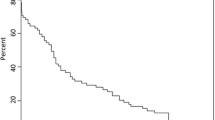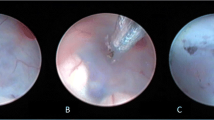Abstract
Purpose
Spinal canal stenosis (CS) occurs in patients with hydrocephalus who are treated with cerebrospinal fluid (CSF) shunting. The pathophysiology of CS comprises CSF overdrainage. We analyzed the incidence of CS and the factors causing it.
Methods
Thirty-three patients who underwent ventriculoperitoneal shunt during childhood visited the Outpatient Department in Yamaguchi University Hospital in 2006. Diameters of spinal canal at C4 were measured. Treatment procedure, age, and type of hydrocephalus in the patients with CS were compared with those without CS.
Results
Of the 33 patients, 10 (30.3%) presented CS, and two (6.1%) were symptomatic. A low-pressure valve caused CS with a significantly higher incidence than a medium- or high-pressure valve (60.0% vs. 17.4%, P < 0.05). Although the difference was not significant, the average age of shunt insertion for a patient with CS was slightly less (0.87 ± 0.99) than for a patient without CS (1.63 ± 1.58). No differences in the CS incidence were observed between obstructive and communicating hydrocephalus.
Conclusion
In order to prevent CS, the hydrocephalus should be appropriately controlled by using a medium- or high-pressure valve until the diameter of the spinal canal reaches the required level. Adjustment of the programmable valve with the patient’s growth should be ideal.



Similar content being viewed by others
References
Hinck VC, Clark WM Jr, Hopkins CE (1966) Normal interpediculate distances (minimum and maximum) in children and adults. AJR 97:141–153
Hinck VC, Hopkins CE, Savara BS (1962) Sagittal diameter of the cerevical spinal canal in children. Radiology 79:97–108
Kajimoto Y, Ohta T, Miyake H, Matsukawa M, Ogawa D, Nagao K, Kuroiwa T (2000) Posture-related changes in the pressure environment of the ventriculoperitoneal shunt system. J Neurosurg 93:614–617
Kobayashi A, Hashi K (1983) Secondary spinal canal stenosis associated with long-term ventriculoperitoneal shunting. J Neurosurg 59:854–860
Liu JK, Gottfried ON, Brockmeyer DL (2006) Epidural venous engorgement resulting in progressive cervical myelopathy from shunt-related intracranial hypotension. Case report and review of the literature. J Neurosurg 105(6 Suppl):499–503
Matsumoto K, Ohta M, Takeshita I (2002) Symptomatic spinal extramedullary mass lesion secondary to chronic overdainage of ventricular fluid. case report. Neurol Med Chir (Tokyo) 42:140–142
Miyake H, Ohta T, Kajimoto Y, Nagao K (2000) New concept for the pressure setting of a programmable pressure valve and measurement of in vivo shunt flow performed using a microflowmeter. Technical note. J Neurosurg 92:181–187
Miyazaki T, Chiba A, Nishina H, Uesaka Y, Nakase H, Kanazawa I (1998) Upper cervical myelopathy associated with low CSF pressure: a complication of ventriculoperitoneal shunt. Neurology 50:1864–1866
Rekate HL, Nadkarni T, Wallace D (2006) Severe intracranial hypertension in slit ventricle syndrome managed using a cisterna magna-ventricle-peritoneum shunt. J Neurosurg 104:240–244
Wingerchuck DM, Patel NP, Patel AC, Dodick DW, Nelson KD (2005) Progressive cervical myelopathy secondary to chronic ventriculoperitoneal CSF overshunting. Neurology 65:171–172
Wolfe SQ, Bhatia S, Green B, Ragheb J (2007) Engorged epidural venous plexus and cervical myelopathy due to cerebrospinal fluid overdrainage: a rare complication of ventricular shunts. Case report. J Neurosurg 106(3 Suppl):227–231
Acknowledgment
This work was supported in part by a Grant-in-Aid for Specially Promoted Research (Project No. 20001008) granted in 2008 to Kyushu Institute of Technology, Yamaguchi University, and Shizuoka University by Japan Ministry of Education, Culture, Sports, Science, and Technology.
Author information
Authors and Affiliations
Corresponding author
Rights and permissions
About this article
Cite this article
Nomura, S., Fujii, M., Kajiwara, K. et al. Factors influencing spinal canal stenosis in patients with long-term controlled hydrocephalus treated with cerebrospinal fluid shunt. Childs Nerv Syst 26, 931–935 (2010). https://doi.org/10.1007/s00381-010-1092-3
Received:
Accepted:
Published:
Issue Date:
DOI: https://doi.org/10.1007/s00381-010-1092-3




